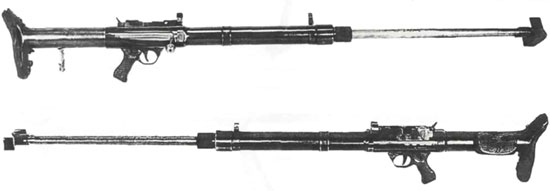Anti-tank rifle Gustloff-Werke Model 1941

Gustloff-Werke Model 1941
In 1940, in order to replace the single-shot anti-tank rifles PzB 38 and PzB 39 in service with the Wehrmacht for the Patrone 318 cartridge, a competition was announced for the creation of new models of self-loading anti-tank rifles. German designers developed a number of experimental self-loading anti-tank rifles with increased combat and operational characteristics, designed to use the same 318 cartridge: Model 40 (PzB 40 W), Model 41 (PzB 40 M), Model 42 (PzB 40 G), Model 43 (PzB 40 K) and Model 44. In October of 1940, thorough multilateral tests of these anti-tank rifles took place.
However, by the time trials began in the fall of 1940, some of the companies, relying on the experience of the French campaign, where the German infantry encountered tanks with armor up to 60-70 mm, had already begun to work on the creation of a new, more powerful weapon that could withstand the enemy’s promising armored vehicles. In this regard, the program to create an automatic anti-tank weapon for the 7.92-mm cartridge 318 was closed as unpromising, and the presented samples of guns remained in prototypes. The designers were asked to start work on more powerful anti-tank rifles.
In the fall of 1941, as part of the Panzerbüchse 243 program for the design of a large-caliber anti-tank rifle, a number of prototypes of German anti-tank guns appeared, which used fairly effective 15x96 mm cartridges from the MG 151 large-caliber aircraft machine gun. The design teams of Gustloff-Werke, Krieghoff, Berlin-Suhler Waffen und Fahrzeugwerke (BSW) and SS-Waffenakademie took part in the competition.
Gustloff-Werke presented a 15 mm self-loading anti-tank rifle, indexed “Model 1941”.
| Caliber, mm | 15x96 |
|---|---|
| Length, mm | 1690 |
| Barrel length, mm | 1170 |
| Weight without cartridges, kg | 18.65 |
The automatics of this gun worked on the principle of recoil of the barrel (its stroke was 186 mm).
The trigger mechanism is hammer-type.
On the left side of the pistol fire control grip, a safety flag was mounted.
A powerful single-chamber jet-type muzzle brake was fixed on the barrel, which significantly reduced recoil.
The weapon was fed with ammunition from an attached box magazine, the receiver of which was located on top of the gun.
The open sights of the weapon were moved to the left.
To reduce recoil, the shoulder rest was equipped with a rubber buffer.
In addition to the 15 mm model of the new anti-tank rifle, the designers of the Gustloff company also proposed a 20 mm version of the anti-tank rifle.
However, the appearance of powerful tanks in the early 1940s made the creation of large-caliber anti-tank anti-tank missiles unnecessary, since the traditional means of anti-tank defense of the infantry turned out to be inpowerful and no longer fully met the requirements of the time. By the end of 1941, the line of capabilities in armor penetration of 60-70 mm at ranges up to 100 m, reached by German anti-tank rifles, with a constant increase in the striking power of armored forces in the armies of the allies in the anti-Hitler coalition, left the Wehrmacht infantry practically unarmed in close combat, and the German anti-tank artillery of direct escort also did not keep up with the development of events at the front. Therefore, all work on the creation of 15-mm anti-tank weapons was stopped, and they remained, embodied only in prototypes.